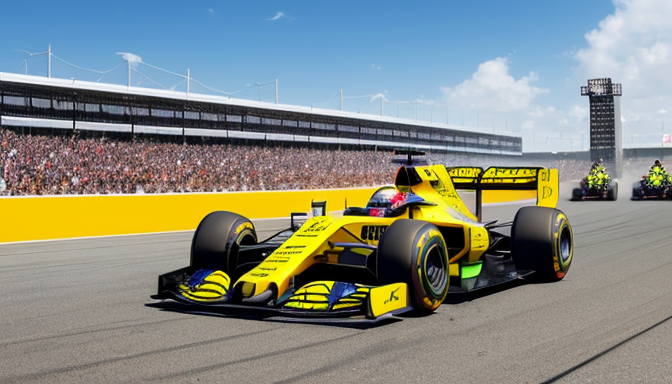Welcome to the exhilarating universe of Formula 1 racing, where the roar of engines and the thrill of speed create an electrifying atmosphere that leaves fans on the edge of their seats. Imagine a world where cutting-edge technology, brilliant strategy, and sheer human determination collide at breathtaking speeds. Each race is not just a contest of speed; it’s a high-stakes chess game played on asphalt. Have you ever wondered what it feels like to be behind the wheel of a car that can go from 0 to 100 km/h in just a few seconds? The adrenaline rush is palpable, and the excitement is contagious!
F1 isn’t just about the cars; it’s about the stories behind them. Picture this: teams of engineers, strategists, and drivers working in unison, like a well-oiled machine, to achieve one goal—victory. The thrill of watching a race unfold is akin to witnessing a live-action blockbuster, where every twist and turn can change the outcome in an instant. From the intense rivalries that ignite the track to the unexpected rain showers that shake up race day, F1 delivers drama, excitement, and unforgettable moments.
As we dive deeper into this world, we’ll explore the remarkable evolution of technology that has transformed F1 racing, making it safer and faster than ever before. So buckle up, because we’re about to accelerate into a realm where every second counts and every decision can make or break a team’s fate!
The Evolution of F1 Technology
When you think of Formula 1, what comes to mind? The roaring engines, the sleek cars, or perhaps the adrenaline-pumping speed? But behind all that thrill lies a world of cutting-edge technology that has evolved dramatically over the years. Gone are the days when drivers relied solely on their skills; today, F1 is a marvel of engineering and innovation. Just imagine a race car that can communicate with its team in real-time, adjusting its performance based on live data. How cool is that?
One of the most groundbreaking advancements in F1 technology is the introduction of hybrid power units. These units combine traditional internal combustion engines with electric motors, allowing teams to maximize performance while being more environmentally friendly. It’s like having your cake and eating it too! The shift towards hybrid technology has not only improved fuel efficiency but has also paved the way for sustainable racing.
Moreover, the integration of data analytics has transformed how teams strategize during races. With sensors embedded in every part of the car, teams can gather invaluable data on tire wear, fuel consumption, and engine performance. This data is analyzed to make split-second decisions, which can be the difference between a podium finish and a disappointing end. It’s like having a crystal ball that helps teams predict and adapt to the ever-changing dynamics of a race.
In conclusion, the evolution of F1 technology is an exciting journey that continues to push the boundaries of what’s possible in motorsports. As fans, we get to witness this incredible fusion of speed and science, making every race an unforgettable spectacle!

The Role of Strategy in F1 Racing
When it comes to Formula 1, it’s not just about the roar of the engines or the adrenaline-pumping speed; it’s about strategy. Imagine a high-stakes chess game played at 200 mph. Every decision, from tire choice to pit stop timing, can make or break a race. Teams meticulously analyze data, weather conditions, and competitor behavior to craft a plan that maximizes their chances of victory. Just like a seasoned chef who knows when to add a pinch of salt, F1 teams must know precisely when to make their moves.
Consider the importance of pit stops. These moments are like a well-rehearsed ballet, where every second counts. A quick tire change can propel a driver from mid-pack to the front, while a botched stop can lead to a lost position or, worse, a missed opportunity for victory. Teams use advanced simulations and real-time data to determine the optimal time to pit, weighing the risks and rewards of each decision.
Additionally, the adaptability of a team during the race is crucial. Conditions can change in an instant—think of rain suddenly pouring down or a rival team making an unexpected move. A successful F1 team is like a skilled surfer riding unpredictable waves; they must stay agile and ready to adjust their strategy at a moment’s notice. The blend of technology, teamwork, and quick thinking creates a thrilling spectacle that keeps fans on the edge of their seats.
In conclusion, the role of strategy in F1 racing is akin to a finely tuned engine—essential for success. It’s the art of anticipating moves, seizing opportunities, and executing plans under pressure. So, the next time you watch a race, remember: it’s not just speed; it’s a masterclass in strategy.
Frequently Asked Questions
- What is Formula 1 racing?
Formula 1 racing is the pinnacle of motorsport, showcasing the fastest cars and the most skilled drivers on a global stage. It’s a thrilling blend of speed, strategy, and cutting-edge technology, delivering heart-pounding action at every turn.
- How has technology evolved in F1?
The evolution of technology in F1 has been revolutionary! From hybrid engines to advanced aerodynamics, innovations have not only improved performance but also enhanced safety. It’s like watching science fiction come to life on the racetrack!
- Why is strategy important in F1?
Strategy is the secret sauce of F1 racing. Teams must carefully plan pit stops, tire choices, and race tactics to outsmart their competitors. Just like a game of chess, every move counts, and the right strategy can lead to victory!
- How do weather conditions affect races?
Weather can be a game-changer in F1! Rain, temperature, and wind can drastically alter track conditions, forcing teams to adapt their strategies on the fly. It’s all about staying one step ahead, like a surfer riding the perfect wave!